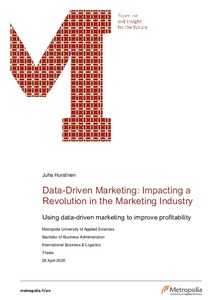Data-driven marketing - Impacting a Revolution in the Marketing Industry : Using data-driven marketing to improve profitability.
Hurstinen, Juha (2020)
Hurstinen, Juha
2020
Julkaisun pysyvä osoite on
https://urn.fi/URN:NBN:fi:amk-2020060517339
https://urn.fi/URN:NBN:fi:amk-2020060517339
Tiivistelmä
Living in a digitised global community induces a combination of instantaneous connectivity with accessible data. Unbeknownst to the consumers who have thrived from data solutions, data analytics on a more advanced level succeeds the digital marketing trend. Marketers with a competitive edge now use the evolved data-driven marketing.
The purpose of this thesis is to highlight this revolutionary change and its effect on industry identity, how marketers operate, and whether this adaptation of marketing teams combined with data science, specifically IT utilising analytics, improve customer experience (CX) optimisation.
This study consisted of exploratory research so analyses were made with qualitative methods in the form of primary data consisting of three interviews surrounding the topics of: executive decision-making, the marketing process and customer journey, and data analytics with its relation to CX optimisation and investment metrics. Further case studies relied on a semi-structured framework of primary sources and secondary data to validate the research. One of the respondents is a chief commercial officer (CCO) with over ten years of marketing experience and education while the other two respondents are highly educated in computational physics and data analytics with one being a chief science officer (CSO) and other being a senior data scientist.
Results further prove that this approach narrowed the scope of decision-making to utilise data analytics to realign marketing investments appropriately. In doing so, marketing decisions have a lower risk factor with marketing investment management and a higher quality of performance measurements from previously analysed marketing campaigns. It is recommended by the author that to enhance the marketing impact, trial demonstrations of analytic solutions to business-to-business (B2B) leads would increase satisfaction, speed up the process of sales funnelling, and lead to product purchasing much faster. Also, adhering to a pricing strategy that is subscription-based would provide a more concrete continuous service as opposed to consultancy projects. The accumulation of these facets would increase the chance of improving the customer experience.
The purpose of this thesis is to highlight this revolutionary change and its effect on industry identity, how marketers operate, and whether this adaptation of marketing teams combined with data science, specifically IT utilising analytics, improve customer experience (CX) optimisation.
This study consisted of exploratory research so analyses were made with qualitative methods in the form of primary data consisting of three interviews surrounding the topics of: executive decision-making, the marketing process and customer journey, and data analytics with its relation to CX optimisation and investment metrics. Further case studies relied on a semi-structured framework of primary sources and secondary data to validate the research. One of the respondents is a chief commercial officer (CCO) with over ten years of marketing experience and education while the other two respondents are highly educated in computational physics and data analytics with one being a chief science officer (CSO) and other being a senior data scientist.
Results further prove that this approach narrowed the scope of decision-making to utilise data analytics to realign marketing investments appropriately. In doing so, marketing decisions have a lower risk factor with marketing investment management and a higher quality of performance measurements from previously analysed marketing campaigns. It is recommended by the author that to enhance the marketing impact, trial demonstrations of analytic solutions to business-to-business (B2B) leads would increase satisfaction, speed up the process of sales funnelling, and lead to product purchasing much faster. Also, adhering to a pricing strategy that is subscription-based would provide a more concrete continuous service as opposed to consultancy projects. The accumulation of these facets would increase the chance of improving the customer experience.
